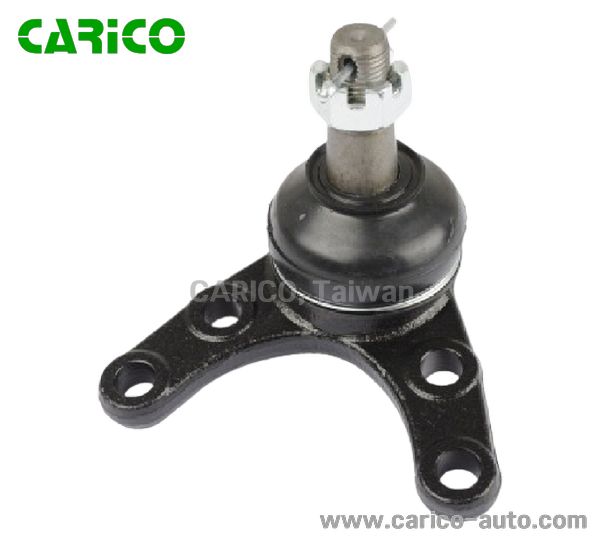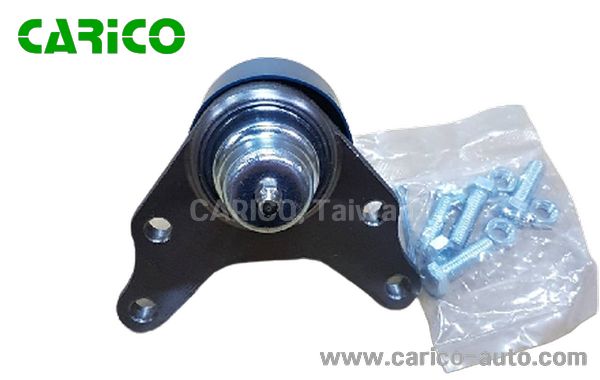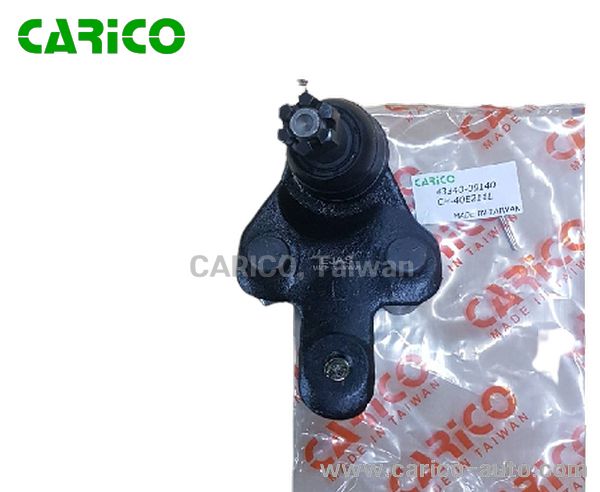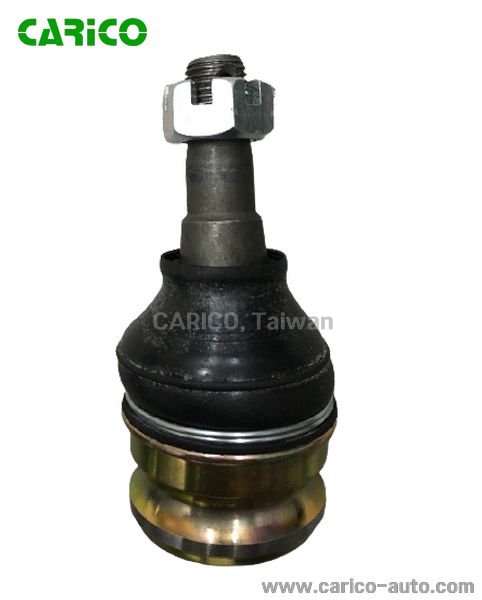The Best Ball Joints - Carico

What is the ball joint?
Ball joints are the pieces of hardware that help keep the wheel attached to the steering wheel. If these fail, then it has to be replaced to prevent accidents and incredible danger, although these small parts can be surprisingly expensive to repair or replace.
You may not know what the Ball Joints are, but they can make all of the difference in how your ride feels.
Ball joints are used to connect the lower control arm to the steering knuckle.They are crucial in making sure that the suspension system is working efficiently.
*Control arms are responsible for providing front suspension movement and stability. Ball joints help in connecting to the steering knuckle which provides a rigid connection point for the lower control arm to travel in an arc around.
⁎Ball joints are one of the crucial parts of a vehicle's suspension system. These ball joints provide a rigid connection between two components, allowing one component to rotate while still providing stability at all times.
⁎Ball joints are semi-universal joints, meaning they can be used on either the right or the left side. They provide a pivot point for the lower control arm and allow for movement along an axis. One such joint is the spherical ball joint. It consists of a ball and socket at two ends with a pin passing through both to provide axial rotation for steering and suspension systems. This type of joint is often used with an outer race bearing and inner cone bearing to reduce wear and noise.
⁎The control arm ball joints exist in various sizes and shapes, depending on their application (e.g., steering, trailing arms). Lower control arm ball joints may also be classified as one-way or two-way depending on their function (e.g., steering direction).
Six Things You Probably Didn't Know About Lowe Control Arm Ball Joints
-
Ball joints are one of the most overlooked components of a suspension system
There are many components in the suspension system that affect the performance in different ways. The tire is one of them, but it is not the only one. Ball joints are often overlooked when it comes to suspension systems, but they can also have a huge impact on how well your car drives around corners, and they play a big role in making sure your tires don't wear out too quickly.
Ball joints are used to connect control arms to steering knuckles, shock absorbers to frames, and tie rods to spindles. They are typically flexible metal structures that allow for movement in two axes - up/down and side/side. If there's too much slack or play in these joints, then this movement will cause the control arm to bend which may lead to other problems like worn out parts and an unstable driving experience.
-
Confusion arises because ball joints are also called ball joints, or sometimes even called "bushings"
Ball joints are usually used in conjunction with other components, such as suspension systems and steering links, to provide a certain amount of movement or articulation. Bushings are used for the opposite purpose - to restrict movement or prevent it altogether.
Ball Joints are not the same as bushings. Ball joints are an important part of the suspension system in a car. They help connect the control arm to the steering knuckle, and they allow for movement in many different directions.
Bushings, on the other hand, are small pieces of metal inside a joint that is meant to reduce friction or create space between moving parts.
During an inspection of your vehicle, it is important that you differentiate between ball joints and bushings to know what needs to be replaced if anything at all is found wrong with either one of them.
-
A ball joint consists of an outer spherical metal sleeve with an inner steel bearing that rotates on it
A ball joint is a mechanical device that connects two pieces of rod or shaft. The components are called the “ball” and the “joint”. The joint has an outer spherical metal sleeve with an inner steel bearing that rotates on it. There is no regular arrangement of the bearings in most designs, but there are some that have matching outer and inner sleeves with a set of balls in-between them, this causes a constant force between both ends of the joint, which is what allows for a fluid range of motion.
A ball joint is a mechanical device that connects two pieces of rod or shaft. The components are called the "ball" and the "joint." A joint has an outer spherical metal sleeve with an inner steel bearing that rotates on it. There is no regular arrangement of bearings in most designs, but there are some notable exceptions. The exception usually involves bearings that are stacked one on top of the other to form a cylindrical shape.
-
The bearing moves back and forth inside to either side as you drive forward or backward
The purpose of the bearing is to allow for the axle to spin freely.
A bearing is a machine element used in rotating or guiding parts, typically those that are rotating or sliding. Bearings are classified broadly as follows:
- Self-aligning bearings use a conical sleeve with matching concave surfaces on either side of it to take up any misalignment between the shaft and housing.
- Ball bearings are spherical bearings that allow multiple rotations in any given direction. They can be used to improve the efficiency of mechanical systems by reducing friction between moving surfaces, allowing for larger displacements, speeds, and masses over the same amount of time before damage occurs.
-
The outer sleeve typically has two holes that connect into the control arm and steering knuckle respectively
The outer sleeve typically has two holes that connect into the control arm and steering knuckle respectively. There are many different types of sleeves, including one-piece sleeves, which are made by casting aluminum or steel around a pressing, welded sleeves, which are made by welding together plates to form an opening for the axle rod to pass through, and bolt-together sleeves, which are made by bolting together plates with openings for the axle rod to pass through.
These sleeves are where the ball joint at the top of the control arm attaches to, and also where the steering knuckle attaches to. These sleeves are typically made out of metal, which can be an issue when they rust. When this happens, it can cause a lot of noise in certain turns or even make your vehicle's front end shake violently when you apply pressure.
Therefore, if you want to keep your vehicle's suspension aligned properly and prevent unnecessary wear, it’s important to inspect your outer sleeves periodically for any signs of rusting or wear.
-
When replacing a ball joint, it is important to replace both sides at the same time
If you replace only one side, the other side will wear out and do not function properly.
Replacing a ball joint is a relatively easy task. You can change it in a few minutes by removing the bolts and replacing the ball joints with a new one. All you need is a wrench and a socket wrench, so it won't take much time to do. Replacing both sides at the same time is important because if you replace only one side, then there isn't any support on that side of your car. The other side will wear out much faster than it would have if you replaced both sides at once.

There are 5 important facts about Ball joints that you should know.
Replace it before it's too late because you never know when these ball joints can fail. It's important to know about all of your car's parts and make sure they are all up-to-snuff because these parts are essential for your safety.
Make sure you are aware of how this part functions, what types of signs tell you that they might need to be replaced, and why it is so vital.
-
They Provide Stability and Accuracy
The control arm is a suspension system on the vehicle that assists in stabilizing the vehicle. It is used to control or counteract the forces that are generated by the weight of the vehicle. The lower ball joints are attached to the control arm and are primarily responsible for transferring loads from front tires to the axle. They also help in providing stability and accuracy when turning corners.
Ball joints are controlled by an inner ball joint, which connects to a lower arm on the control arm. When there is excessive movement caused by corrosion or metal fatigue, it can lead to failure of these joints. They may also experience wear due to long use of lubricant which can cause degradation of parts and eventually lead them to fail as well if not taken care of at time intervals set out by manufacturer recommendations.
The main purpose is to provide stability by connecting the chassis to the wheel hub assembly at a single point. The ball joint allows for rotation in all directions, while also providing accurate positioning of the wheels.
- They are Used in Various Applications Including Vehicle Suspensions and Industrial Equipment
A lower control arm ball joint is designed to withstand large loads and vibrations because it has to hold up the weight of an automobile or machine for prolonged periods. Without lower control arm ball joints, drivers would lose steering ability and their cars would not be able to move in any direction.
The Lower Control Arm ball joints are a type of ball joint that connects the lower control arm to the axle.
It is also called a Half-shaft joint or a control arm joint.
The ball joint is made up of two parts:
- The Ball Joint: The ball part has a hole in it and attaches to the lower control arm, and the other part has an opening and attaches to the vehicle's axle.
- The Grease Seal: The grease seal attaches to the axle’s end of the connection. It prevents grease from leaking out as it provides protection from dirt and dust as well as water corrosion.
- Failure of the Ball Joint May Cause an Immediate Collapse of the Suspension or Equipment System Under Load
The ball joint is the connection point between the suspension arm and the axle of a vehicle. It helps to control the movement of one or both wheels in relation to each other.
The ball joint is made up of an upper and lower ball with a stud that connects them. The stud has what is called a bushing with grease in it which prevents any metal-on-metal contact, which could lead to wear or even corrosion.
A failure in this area can cause an immediate collapse of the suspension or equipment system under load. This will result in catastrophic vehicle damage, injury, death, and expensive repairs for your vehicle.
- They Fail Due to Wear & Tear or Defective Manufacturing Which Can Result in Expensive Repairs
Vehicles are maintained and repaired for a variety of reasons. One reason is that they may need to be repaired due to wear and tear or defective manufacturing which can result in expensive repairs.
Vehicles should be maintained and repaired for a variety of reasons. One reason is that they may need to be repaired due to wear and tear or defective manufacturing which can result in expensive repairs.
It doesn't matter what the vehicle is, it needs to be maintained at certain intervals so that it does not go through problems such as being extremely costly or having extremely bad performances on the road.
Wear and tear of tires is inevitable. However, the rubber on the tires of a car that has been poorly manufactured can wear out much faster.
If your tires are not in good condition, it can cause you to have accidents, leading to expensive repairs.
- Replacing methods Your Lower Control Arm Ball Joints
If your vehicle's lower control arm ball joint has worn out or has completely broken down, it's time that you replace them with new ones.
To replace these important components without any issue, follow these simple steps:
The most common method of replacing your lower control arms is to remove them from the car. This means that the car will need to be either jacked up and supported on jack stands or on a lift. Do not remove the lower control arm from the upper ball joint until you have removed the upper ball joint.
PRODUCTS
SUSPENSION SYSTEM
STEERING SYSTEM
BRAKE SYSTEM
ENGINE SYSTEM
ADJUSTABLE PARTS (SUB-BRAND FOTADO,ODM)





